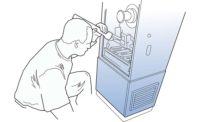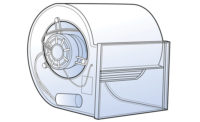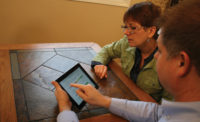It’s frustrating when a customer complains that their older, inefficient furnace did a better job heating their home than their new, high-efficiency furnace. Some common issues they mention are that the furnace doesn’t maintain comfort, it runs too long, or the gas bills didn’t drop as promised.
Does this sound familiar? What if there is something more you can do to figure out what’s going on? Let’s explore how to check furnace heating output in four steps and see what clues it provides.
Furnace Output is Sensible Heat
Furnace Btu output is sensible heat. It is how much heat the furnace produces when it warms the air that moves across the heat exchanger. With a few measurements, you can determine how much heat a furnace delivers. We do this using the sensible heat formula, cfm x ∆t x 1.08.
To check furnace Btu output, gather the readings necessary to complete the formula.
- cfm = fan airflow
- ∆t = temperature rise across the furnace
- 1.08 = a multiplier based on standard air conditions
Let’s say you test a gas furnace rated at 64,000 Btu output and measure the following:
- Fan airflow = 1,035 cfm
- Temperature rise = 55.9° ∆t
Put these readings in the formula, and it would appear like this:
1,035 cfm x 55.9° ∆t x 1.08 = 62,485 Btus
When your measurements are within 10% of the furnace’s nameplate output rating, you know the furnace is doing what it should. In this example, the furnace should deliver 64,000 Btus and you calculate 62,485 Btus, so all is well with the furnace. Now let’s look at the test instruments you will need and how to gather these readings, so you can try it yourself.
Test Instruments
To gather your measurements, you’ll need a manometer to measure static pressures and a dry bulb thermometer to measure temperatures. You can also use an anemometer (thermal or hot-wire) for airflow measurements. The choice depends on how much information and accuracy you want.
Step One: Prepare for Testing
It’s a good idea to think about safety first when you test fuel-fired equipment. Two important issues to consider are ambient carbon monoxide (CO) and gas leaks. Make sure the conditions you test in are safe before you proceed.
Your first stop is the gas furnace where you will record some basic information from the furnace nameplate. These include:
- Model number
- Rated Btu input and output
- Maximum-rated total external static pressure (TESP)
- Temperature rise range (∆t)
Besides the nameplate information, gather the fan speed setting for heating operation and locate the furnace installation instructions. You’ll need them to use the fan table. Make sure there are test ports to measure static pressure and temperature. If they are missing, install them in the correct locations.
Step Two: Check Fan Airflow
Once you have the furnace information and everything set up, take measurements to complete the formula. First, estimate the furnace’s target airflow. It is the amount of airflow the furnace fan needs to circulate. Read more about how to estimate required gas heating airflow here.
Once you know target airflow, it’s time to measure fan airflow. There are multiple ways to check it. The most common methods are:
- Measure TESP with a manometer and plot fan airflow using the manufacturer fan table
- Perform a duct traverse with an anemometer (if you have a good test location)
- Check the furnace controller display on a communicating system.
For this article, we will use TESP and the furnace manufacturer’s fan table.
First, set your manometer to measure TESP. Attach pressure tubing to each manometer port. One tube is for the positive port, and the other is for the negative port. Then fasten static pressure tips to the open ends of the pressure tubing.
Use one static pressure tip to measure furnace entering pressure, and use the other to measure exiting pressure. You will see the measured TESP on the manometer’s display. Record this reading and then grab the manufacturer’s fan table.
Find the measured TESP and fan speed on the fan table and intersect them to plot fan airflow — the first piece of information in the formula.
Step Three: Measure Furnace Temperature Rise
Next, measure the furnace temperature rise. Temperature measurement works best when you use a fast-acting digital thermometer. Dual probe or wireless probes make this step even quicker and increase reading accuracy.
Measure and record the furnace entering (return) and exiting (supply) temperatures. Make sure the furnace has warmed up before you take these measurements. Avoid any heat source that could affect your readings, like a duct leak, motor heat, or radiant heat from the heat exchanger. If you use a single thermometer, start with the return temperature, and then measure your supply temperature.
Subtract the two temperature readings to determine the furnace temperature rise or delta t (∆t) — the second piece of information in the formula.
Step Four: Calculate Heating Output and Compare to Rated Output
When you have airflow (cfm) and temperature rise (∆t), you can finish the sensible heat formula. The results let you see how close you are to the furnace’s nameplate rated Btu output. Remember, results within 10% of the nameplate output rating are the goal.
If your results are significantly off, double check how you took your measurements. Inaccurate readings or poor test locations can affect your numbers and results. If you’re confident in your measurements, compare them to their target airflow and temperature readings.
First, compare target fan airflow to your measured fan airflow. It should be within ± 10% of target airflow. Next, compare the furnace nameplate temperature rise range to your measured temperature rise — it should be in the mid-range. The values that are off the most are the ones you want to investigate further.
Next Steps
Your airflow and temperature measurements will guide your next steps. If you find low furnace airflow, there is a good chance additional airside diagnostic testing and duct repairs are in order. However, if you have high airflow, it’s a little easier to correct. Adjust the fan speed to get close to your target airflow. If you measured high airflow with a low temperature rise, there’s a good chance the temperature rise will improve once you change the airflow.
If you have a natural gas furnace, you can also clock the gas meter to eliminate low input as a potential problem. Any time you deal with fuel-fired equipment, it’s best practice to combustion test the equipment. With the proper training, the test results provide additional clues that can assist your troubleshooting efforts.
We started the article with a list of customer complaints. They ranged from the new furnace not maintaining comfort to gas bills that didn’t improve. What if you find yourself in this situation and the furnace’s rated output is close to the nameplate rating? What would you do next?
The customer still has a complaint, but the furnace isn’t the problem. You’ll want to look at five reasons HVAC systems don't maintain comfortable conditions to move your diagnostics past the equipment. The additional sources you discover that affect your customer’s comfort may surprise you.








